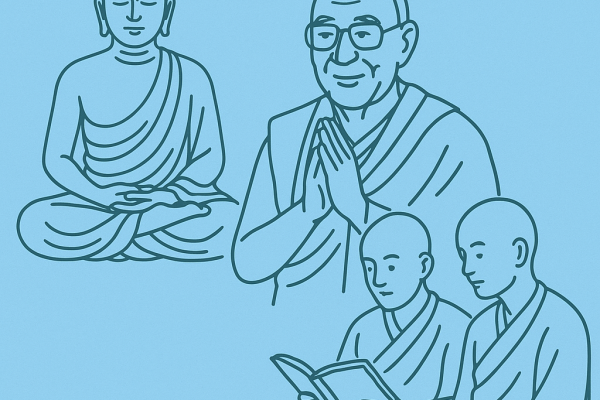Buddhism, one of the world’s oldest spiritual traditions, continues to spark curiosity among millions seeking wisdom, peace, and enlightenment. From questions about Buddha’s origins to daily practices like diet, tattoos, and meditation, people often turn to Google for answers. To provide clarity, our experts have answered some of the most searched questions about Buddhism, drawing insights from authentic Buddhist scriptures such as the Pali Canon, Vinaya Pitaka, and Mahayana Sutras. Whether you’re exploring Buddhism for the first time or deepening your understanding, these expert-backed responses will guide you with accuracy and tradition. Can I be Buddhist if I’m white? Yes, Buddhism is a spiritual path open to all, regardless of race or ethnicity. The Buddha’s teachings focus on wisdom, compassion, and self-awareness, and anyone can follow them. Many Westerners have embraced Buddhism over the years. Reference: The Dhammapada, Theravāda Buddhism Texts How many hours did Buddha sleep? According to Buddhist scriptures, the Buddha slept for about 4 hours a night, from 10 PM to 2 AM. He dedicated the rest of his time to meditation and teaching. Reference: Vinaya Pitaka, Theravāda Canon Can you drink alcohol if you’re a Buddhist? Buddhism generally discourages alcohol consumption as it clouds the mind and hinders mindfulness. The Fifth Precept advises against intoxicants that lead to heedlessness. Reference: Sigalovada Sutta, Dīgha Nikāya Is it OK to keep a Sleeping Buddha at home? Yes, keeping a Sleeping Buddha statue at home is fine, as long as it is placed respectfully in a clean and elevated area. It symbolizes peace, enlightenment, and the transition to Nirvana. Reference: Buddhist Art and Iconography Texts What is unusual about a Buddhist marriage? Buddhist marriages are generally simple and secular. Buddhism does not prescribe specific rituals but emphasizes mutual respect, love, and understanding between partners. Many Buddhists seek blessings from monks rather than conducting religious ceremonies. Reference: Sigalovada Sutta, Dīgha Nikāya Can Buddhists have tattoos? Yes, Buddhists can have tattoos, and many choose sacred symbols or mantras. However, in some Buddhist cultures, tattooing sacred images (like the Buddha) on inappropriate body parts may be considered disrespectful. Reference: Theravāda & Mahāyāna Teachings on Respect Can Buddhists drink caffeine? Yes, Buddhists can drink caffeine. However, some monastic traditions may limit or avoid it to maintain mindfulness and avoid over-stimulation. Reference: Vinaya Pitaka, Monastic Rules Can Buddhists eat pork? It depends on the tradition. Theravāda monks traditionally eat whatever is offered, including pork, as long as the animal was not killed specifically for them. Many Mahāyāna Buddhists, especially in China and Vietnam, follow vegetarian diets. Reference: Jivaka Sutta, Anguttara Nikāya Is Buddha Chinese or Indian? The Buddha, Siddhartha Gautama, was born in Lumbini, present-day Nepal, and attained enlightenment in India. His teachings spread from India to China, Tibet, and other parts of Asia over centuries. Reference: Mahāparinibbāna Sutta, Theravāda Canon Are Buddhists Christians? No, Buddhism and Christianity are separate religions with different beliefs. Buddhism does not revolve around a creator god, while Christianity is centered on faith in God and Jesus Christ. However, some individuals appreciate and incorporate elements of both traditions in their personal spiritual journey. Reference: Buddhist-Christian Dialogue Texts What is the meaning of Baudh Dharma? “Baudh Dharma” (Buddhism) means the path of awakening or enlightenment, based on the teachings of the Buddha. It emphasizes wisdom, compassion, and liberation from suffering. Reference: The Four Noble Truths, Pali Canon What is Buddha’s religion? The Buddha did not follow an existing religion but taught a path to enlightenment based on personal experience. His teachings later became known as Buddhism. Reference: Dhammacakkappavattana Sutta, Pali Canon Which country is 100% Buddhist? No country is 100% Buddhist, but Bhutan and Cambodia have the highest percentages, with over 90% of their populations following Buddhism. Reference: Pew Research on Religious Demographics What are the 4 principles of Gautam Buddha? The Four Noble Truths form the core of Buddha’s teachings: Reference: Dhammacakkappavattana Sutta, Pali Canon Buddhism’s timeless wisdom continues to inspire curiosity and spiritual exploration worldwide. Through authentic scriptures and expert insights, we have addressed some of the most frequently asked questions, offering clarity on Buddhist beliefs, practices, and traditions. However, these are just a few of the many questions people seek answers to. For a more in-depth exploration, including additional queries on Buddhism, visit IBH Forum’s Most Asked Questions on Buddhism and deepen your understanding of this profound path to enlightenment.










